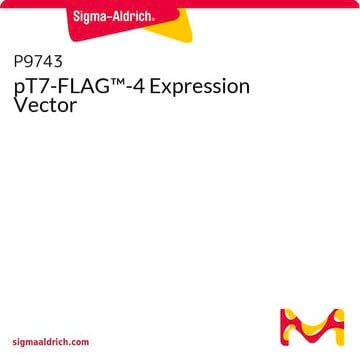E7658
p3XFLAG-CMV™-10 Expression Vector
shuttle vector for transient or stable expression of N-terminal 3xFLAG
Sign Into View Organizational & Contract Pricing
All Photos(2)
About This Item
UNSPSC Code:
12352200
eCl@ss:
32190102
Recommended Products
tag
3X FLAG tagged
grade
for molecular biology
form
buffered aqueous solution
Peptide tag location
N-terminal
shipped in
dry ice
storage temp.
−20°C
General description
The p3XFLAG-CMV™-10 Expression Vector is a 6.3 kb derivative of pCMV5 used to establish transient or stable intracellular expression of N-terminal 3XFLAG™ fusion proteins in mammalian cells. The vector encodes three adjacent FLAG® epitopes (Asp-Tyr-Lys-Xaa-Xaa-Asp) upstream of the multiple cloning region. This results in increased detection sensitivity using ANTI-FLAG M2 antibody. The third FLAG epitope includes the enterokinase recognition sequence, allowing cleavage of the 3XFLAG peptide from the purified fusion protein. Efficiency of replication is optimal when using an SV40 T antigen expressing host.
The p3XFLAG-CMV-7-BAP Control Plasmid is a 6.2 kb derivative of pCMV5 used for transient intracellular expression of N-terminal 3X-FLAG bacterial alkaline phosphatase fusion protein in mammalian cells. The vector encodes three adjacent FLAG epitopes (Asp-Tyr-Lys-Xaa-Xaa-Asp) upstream of the multiple cloningregion. This results in increased detection sensitivity using ANTI-FLAG M2 antibody. The third FLAG epitope includes the enterokinase recognition sequence, allowing cleavage of the 3XFLAG peptide from the purified fusion protein.
Vector Maps and Sequences
The p3XFLAG-CMV-7-BAP Control Plasmid is a 6.2 kb derivative of pCMV5 used for transient intracellular expression of N-terminal 3X-FLAG bacterial alkaline phosphatase fusion protein in mammalian cells. The vector encodes three adjacent FLAG epitopes (Asp-Tyr-Lys-Xaa-Xaa-Asp) upstream of the multiple cloningregion. This results in increased detection sensitivity using ANTI-FLAG M2 antibody. The third FLAG epitope includes the enterokinase recognition sequence, allowing cleavage of the 3XFLAG peptide from the purified fusion protein.
Vector Maps and Sequences
Components
p3XFLAG-CMV™-10 Expression Vector 20 μg (E4401) is supplied as 0.5 mg/ml in 10 mM Tris-HCl (pH 8.0) with 1 mM EDTA.
p3XFLAG-CMV™-7-BAP Control Plasmid 20 μg (C7472) is supplied as 0.5 mg/ml in 10 mM Tris-HCl (pH 8.0) with 1 mM EDTA.
p3XFLAG-CMV™-7-BAP Control Plasmid 20 μg (C7472) is supplied as 0.5 mg/ml in 10 mM Tris-HCl (pH 8.0) with 1 mM EDTA.
Principle
The promoter-regulatory region of the human cytomegalovirus3 drives transcription of FLAG®-fusion constructs. The aminoglycoside phosphotransferase II gene (Neo-r) confers resistance to aminoglycosides such as G418 allowing for selection of stable transfectants.
Legal Information
This product is covered by the following patents owned by Sigma-Aldrich Co. LLC: US6,379,903, US7,094,548, JP4405125,EP1220933, CA2386471 and AU774216.
3xFLAG is a trademark of Sigma-Aldrich Co. LLC
FLAG is a registered trademark of Merck KGaA, Darmstadt, Germany
p3xFLAG-CMV is a trademark of Sigma-Aldrich Co. LLC
Storage Class Code
10 - Combustible liquids
Certificates of Analysis (COA)
Search for Certificates of Analysis (COA) by entering the products Lot/Batch Number. Lot and Batch Numbers can be found on a product’s label following the words ‘Lot’ or ‘Batch’.
Already Own This Product?
Find documentation for the products that you have recently purchased in the Document Library.
Kamlesh K Bisht et al.
Journal of cell science, 126(Pt 15), 3493-3503 (2013-06-05)
Sister chromatid cohesion relies on cohesin, a complex comprising a tri-partite ring and a peripheral subunit Scc3, which is found as two related isoforms SA1 and SA2 in vertebrates. There is a division of labor between the vertebrate cohesin complexes;
Immacolata Cristina Nettore et al.
Thyroid : official journal of the American Thyroid Association, 23(6), 675-682 (2013-02-06)
NKX2-1 mutations have been described in several patients with primary congenital hypothyroidism, respiratory distress, and benign hereditary chorea, which are classical manifestations of the brain-thyroid-lung syndrome (BTLS). The NKX2-1 gene was sequenced in the members of a Brazilian family with
Yan Ren et al.
Molecular & cellular proteomics : MCP, 12(2), 485-498 (2012-12-04)
Tumor hypoxia induces cancer cell angiogenesis, invasiveness, treatment resistance, and contributes to poor clinical outcome. However, the molecular mechanism by which tumor hypoxia exerts a coordinated effect on different molecular pathways to enhance tumor growth and survival and lead to
Masaki Kamio et al.
Oncogene, 23(17), 3107-3115 (2004-03-17)
Human papilloma viruses (HPVs) are small double-stranded DNA viruses that infect mucosal and cutaneous epithelium and induce cervical cancer. It has been shown that interferon (IFN)gamma suppresses proliferation of HPV-infected cells by suppressing expression of HPV E7. Here, we found
Qi Ming Li et al.
The Journal of neuroscience : the official journal of the Society for Neuroscience, 27(31), 8395-8404 (2007-08-03)
Although oligodendrocytes undergo apoptosis after spinal cord injury, molecular mechanisms responsible for their death have been unknown. We report that oligodendrocyte apoptosis is regulated oppositely by c-Jun N-terminal kinase 3 (JNK3) and protein interacting with the mitotic kinase, never in
Our team of scientists has experience in all areas of research including Life Science, Material Science, Chemical Synthesis, Chromatography, Analytical and many others.
Contact Technical Service








